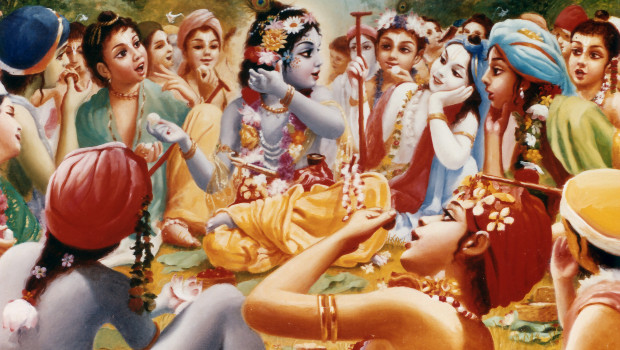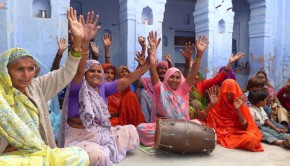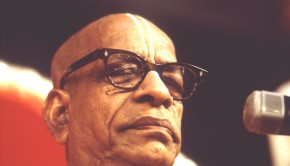The Hare Krishna Maha Mantra — Effects on Stress, Depression, and the Three Gunas
ABSTRACT
EFFECTS OF THE HARE KRSNA MAHA MANTRA ON STRESS, DEPRESSION, AND THE THREE GUNAS
The author conducted a 3-group study on the effects of chanting the hare krsna maha mantra on stress, depression, and the three modes of nature–sattva, rajas, and tamas–described in the Vedas as the basis for human psychology. Sixty-two subjects, self-selected through newspaper advertisements in a Southeastern university town, completed the study. Average age was 24.63 years, with 31 males and 31 females participating. Stress was measured with the Index of Clinical Stress, depression was measured with the Generalized Contentment Scale, and the modes of nature, or gunas, were measured with the Vedic Personality Inventory. Subjects were tested at pretest, posttest, and followup, with testing times separated by four weeks. Participants were randomly assigned to a maha mantra group, an alternate mantra group, and a control group. Subjects in each of the chanting groups chanted their mantra approximately 25 minutes each day. The researcher concocted a mantra as the alternate mantra, though subjects in the alternate group thought it was a genuine Vedic mantra. Primary hypotheses of the study were based on Vedic theory, and stated that the maha mantra group would increase sattva, and decrease stress, depression, rajas and tamas, significantly more than the other two groups. ANCOVA results, controlling for gender and age, supported these hypotheses at p<.05 for all dependent variables except rajas, with effect sizes (eta2) for the four variables whose results supported the hypothesis ranging from .21 to .33. The author suggests that the maha mantra has potential for utilization in clinical areas similar to those where other interventions of Eastern origin have been successful, such as treatment of stress, depression, and addictions. Further, it is recommended that the maha mantra be integrated into a spiritual approach to client care in social work and related fields. Suggestions for further research include applying path analysis to the data of this study to ascertain causal relationships, and application of Hierarchical Linear Models to the data to combine single-system analysis and group analytical methods for extracting the maximum amount of information. Additionally, further studies on the maha mantra are warranted, with various populations and in various settings.
Name: David Brian Wolf
Department: School of Social Work
Major Professor: Dr. Neil Abell
Degree: Doctor of Philosophy
Term Degree Awarded: Summer, 1999
CHAPTER 1
THEORETICAL BACKGROUND
This dissertation focuses on a group experiment that was conducted on the effects of chanting the hare krsna maha mantra, a mantra emphasized in the literature from ancient India for its efficacy in relieving stress, depression, and other mental health disturbances (Prabhupada, 1976). Therefore, chapter 1 presents some basic theoretical concepts, derived from the Eastern Vedic literatures, necessary for understanding the process of chanting mantras, chapter 2 contains a review of the literature on spiritual interventions, a term which will be defined in chapter 1. The Vedas describe the Hare Krsna maha mantra as a spiritually-based intervention for psychological upliftment (Prabhupada), and therefore it is appropriate to study related theory and literature on spiritual approaches to mental health improvement.
Considering the person-in-environment orientation of the social work profession, spirituality and religion must be acknowledged and respected by social workers, as these factors are an integral part of practically every human culture, and they frequently play a central role in the lives of many people. Canda (1988) emphasizes the importance for social workers to take into account the spiritual needs of clients so that the fullness of the clients’ human dignity and potential is recognized and respected in all helping situations. He asserts that spirituality is a basic aspect of human experience, both within and outside the context of religious institutions, and that it therefore should be explored more fully through social work practice, research, and theory building. In the United States, Gallup Poll data consistently show that approximately 95% of the population believes in God, and about half the population is actively religious on at least a weekly basis (Paloutzian & Kirkpatrick, 1995). As the following literature review will show, religious and spiritual dimensions are among the most important cultural factors structuring human experience, beliefs, values, behavior, and illness patterns. It is justifiable, therefore, for helping professionals to consider the religious and spiritual components of clients’ lives in attempts to serve the client population.
Bullis (1996) writes “Traditionally, social work literature has reluctantly addressed religion’s or spirituality’s impact on clinical practice” (p. 6). He attributes this to the historic rift between the religious and psychoanalytic movements, the alleged atheistic orientation of social workers, and economic, political, and professional competition between religious professionals and secular social workers. Bullis continues “For the most part spirituality in social work literature is conspicuous only by its absence” (p. 6).
If a multicultural perspective is to be more than a facade for social workers, the phenomena of religion and spirituality must be genuinely appreciated. The term “genuinely appreciated” is emphasized herein, since Western approaches to diversity sometimes involve a patronizing pseudo-respect meant to veil a proselytizing mission that seeks to undermine long-held spiritual and religious beliefs and replace them with a relativistic viewpoint. Bellah et al. (1991) relate excerpts from a talk given a few years ago by a student speaker at a Harvard University graduation: There is one experience that I believe we have all acquired during our career at this fine institution, and that, ladies and gentlemen, in a word, is confusion. The freedom of our day is the freedom to devote ourselves to any values that we choose, on the mere condition that we don’t believe them to be true. (pgs. 43-44)
So, for social workers, whose profession has roots in spiritual and religious humanitarianism (Dolgoff, Feldstein, & Skolnik, 1993), it may be a good idea to objectively examine the literature on spirituality as it relates to the many facets of social work. To reject such literature as being non-scientific due merely to its content, without consideration of its methodology and substantive results, may be considered dogmatism.
To read the complete paper please click on the following link to download the PDF file:
The Hare Krishna Maha Mantra — Effects on Stress, Depression, and the Three Gunas















Hare krishna prabhuji
i am doing research on hare krishna mahamantra can i got any link with you to contact atao discuss further for same
You need to read all of Prabhupada’s books, there you will find the science of how to chant the Hare Krishna mantra. It is a bit study, you need to spend some time on it. You can get the books here:
https://krishnastore.com/books-srila-prabhupada-om-21_38.html
Hare Krishna. PAMHO. I would like to do research on Hare Krishna Mahamantra effect on Stress level. Am a Speech Language Pathologist as profession. And also Preacher for youth and working professional. I am seeking help from u for the same to have some research.
Hare Krshna
Whenever you are depressed or don’t know what to do do start chanting Hare Krishna Hare Krishna Krishna Krishna Hare Hare Hare Rama Hare Rama Rama Rama Hare Hare
Dear All
I am an artist from Mumbai, India. I often visit many place of the world to develop vision but love Guru/ shishya. I am a sishya of krishna and that take me to you. I would be amazed if I can help you in your schools teaching art to students anywhere in the world.
Hare Krishna
Nanda Das